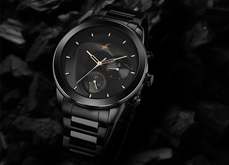Author: Dr Tess Skryme, Senior Technology Analyst at IDTechEx
Tunneling magneto resistance sensors are rapidly disrupting the automotive and wearables industry. These tiny sensors leverage quantum phenomena to provide a performance edge over classical incumbents, including industry mainstays such as Hall effect sensors. Although they don’t depend on the more exciting effects such as superposition and entanglement, in this article, IDTechEx highlights the lessons to be learned from the success of TMR sensors in the emerging quantum sensor market.
Sensitivity is the key to unlocking commercial value
TMR sensors use quantum tunneling for highly sensitive measurements of magnetic field. They are constructed from a sandwich of thin layers of ferromagnet and nanometer-thick insulator. Thanks to quantum, the probability of electrons tunneling through these layers has a strong dependence on external fields – both magnetic and electric. TMR sensors can be integrated into circuits that exhibit an easily measurable change in voltage or resistance and detect magnetic fields hundreds of times smaller than established incumbents.
Figure 1. Operating principle of a TMR sensor (top). Comparing the output response of a TMR to GMR and AMR. Source: IDTechEx
Figure 1. Operating principle of a TMR sensor (top). Comparing the output response of a TMR to GMR and AMR. Source: IDTechEx
Many other quantum sensing technologies are in development, including even more magnetic field sensors, as well as clocks, gravimeters, gyroscopes, and photodetectors. In each instance, these technologies have the potential to offer orders of magnitude increases in sensitivity and, therefore, as a group, are likely to prove highly disruptive to the existing sensor market.
The importance of optimized SWAP-C
Sensitivity isn’t the only parameter of importance in the sensor market. Optimizing the size, weight, power, and cost, or SWAP-C, is also paramount. For TMR sensors, reduced power consumption compared to Hall sensors has proved crucial in tempting OEMs to switch. This reflects demand across the IoT space for lower power devices, allowing them to operate for longer and ultimately make their operation more sustainable from a maintenance and environmental perspective.
Figure 2. Comparing key properties of miniaturized magnetic field sensors. Source: IDTechEx
Figure 2. Comparing key properties of miniaturized magnetic field sensors. Source: IDTechEx
The relative simplicity of TMR sensor architecture has allowed for highly optimized SWAP-C, as they can be manufactured using CMOS techniques in established semiconductor foundries. The miniaturization of TMR sensors not only competes with more established solutions but, in many instances, exceeds it. Yet, this will likely prove far more challenging for the next generation of quantum sensors. The components and infrastructure required to contain solutions based on entanglement and superposition are far more complex than tunneling. Scalable manufacture of vapor cells, lasers, nitrogen-vacancy centers, and more remains a high-value technical challenge for the quantum technology industry to solve.
The advantage of use-case diversity
The applications of TMR sensors for wake-up, angle and position sensing, and remote current sensing have applications in multiple industry verticals. Many wearable and medical devices depend on wake-up functionality, including continuous glucose monitors for diabetes management and hermetically sealed digital pills. Remote sensing and temperature robustness offer enhanced safety for monitoring within both electric vehicles and solar energy systems. As for position and angle sensing, there are almost limitless uses, but with notable value for wind-turbine power optimization, robotics, and factory optimization.
The diversity of use cases and, therefore, industries addressable with TMR technology provides an advantage in scaling up production. While new sensors may be able to compete on sensitivity, size, and power – limited economies of scale upon commercialization almost always leads to an initial compromise on cost. Finding early adopters in high-value industries allows the runway to increase manufacturing capacity before entering higher-volume markets. This has arguably been the case for TMR sensing, using a sub-set of the electric vehicle market as a springboard for consumer electronics. The success of this approach is evidenced by the recent activity of leading players in the TMR sensor industry – with TDK doubling their production capacity and Crocus surpassing 100-million-unit sales.
Figure 3- Market Size vs. CAGR plot. Outlook for quantum sensors 2024-2034. Vertical agnostic devices predicted to obtain higher volume sales.
Figure 3- Market Size vs. CAGR plot. Outlook for quantum sensors 2024-2034. Vertical agnostic devices predicted to obtain higher volume sales.
IDTechEx predicts that vertical agnosticism will likely also pay off for more complex devices in the quantum sensor market. Remaining use-case specific can result in a stalemate on cost optimization and could become a challenge for certain devices such as gravimeters, where underground mapping is the only clear killer application. Yet for atomic clocks and quantum gyroscopes, there are already indicators of future adoption for precision navigation and timing into the aerospace, automotive, finance, and even consumer electronics markets. It may well be that diversity of application is an essential driver for the long-term commercial success of these quantum sensors over others.
Outlook and conclusion
TMR sensors are adding commercial value in multiple industries through high sensitivity and optimized size, weight, and power consumption. This technology is an example of how quantum effects can be leveraged to disrupt the market for classical sensors. Although admittedly a relatively simple case, developers of more advanced quantum sensors will benefit from developing solutions with a similar package of qualities. Beyond this, it is perhaps also a lesson that relying on the use of ‘quantum’ is insufficient as a marketing tool on its own.
For more information on the commercial outlook for all the sensor technology mentioned in this article, including twenty-year market forecasts, see IDTechEx’s latest report on the Quantum Sensor Market, “Quantum Sensors Market 2024-2044”. To find out more about this report please visit www.IDTechEx.com/QuantumSensors. Find coverage of related topics in IDTechEx reports on Quantum Computers, Wearable Technology and Electric Vehicles at www.IDTechEx.com/Research.
 Newspatrolling.com News cum Content Syndication Portal Online
Newspatrolling.com News cum Content Syndication Portal Online





